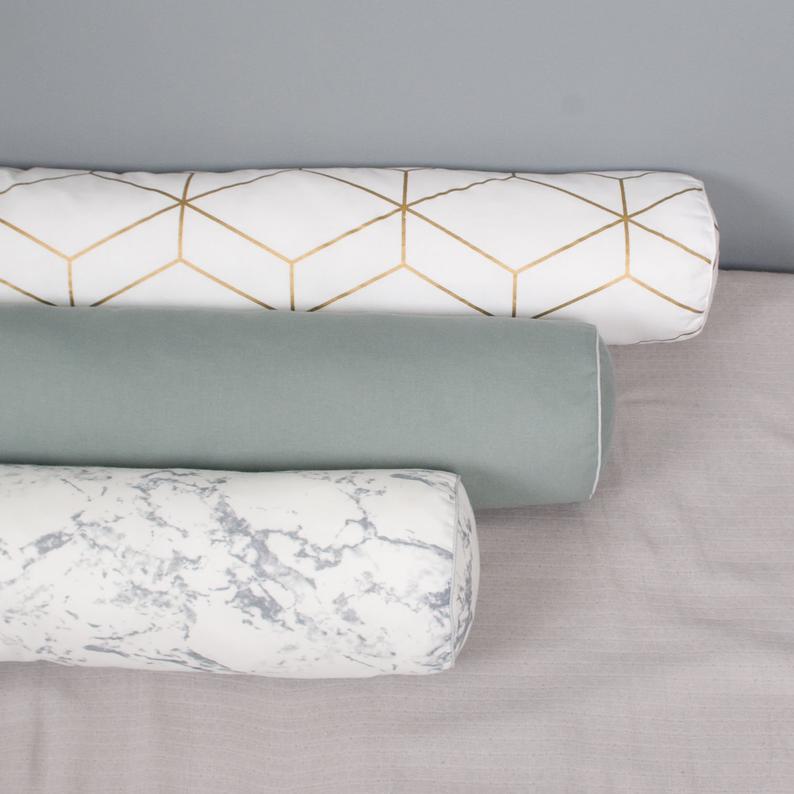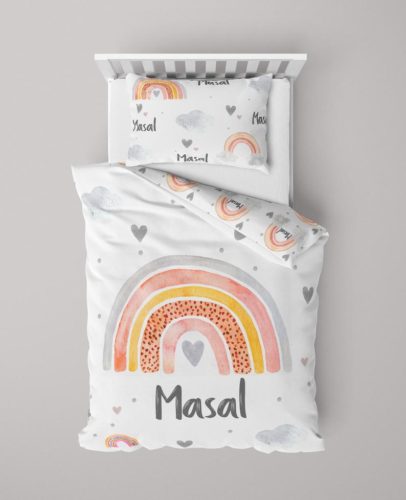If you have a toddler, you may be considering transitioning out of the crib. You most likely have many questions and concerns.
Every transition with children is challenging and we begin to second guess ourselves because we want the best for them.
While I do have my Masters in Early Childhood Education, have worked many years in the classroom and with children, and have been trained in Montessori education, I am still a new parent and these types of transitions are challenging for me as well.
Ruby is my first child and being a parent is a whole lot different than teaching in a classroom. We are one month into transitioning to a floor bed at this point, but things are going well. So, here is some insight I have learned along the way.
Disclosure: This post may contain affiliate links, which means we may receive a commission if you click a link and purchase something that we have recommended. While clicking these links won’t cost you any extra money, they will help us keep this site up and running! Please check out our disclosure policy for more details.
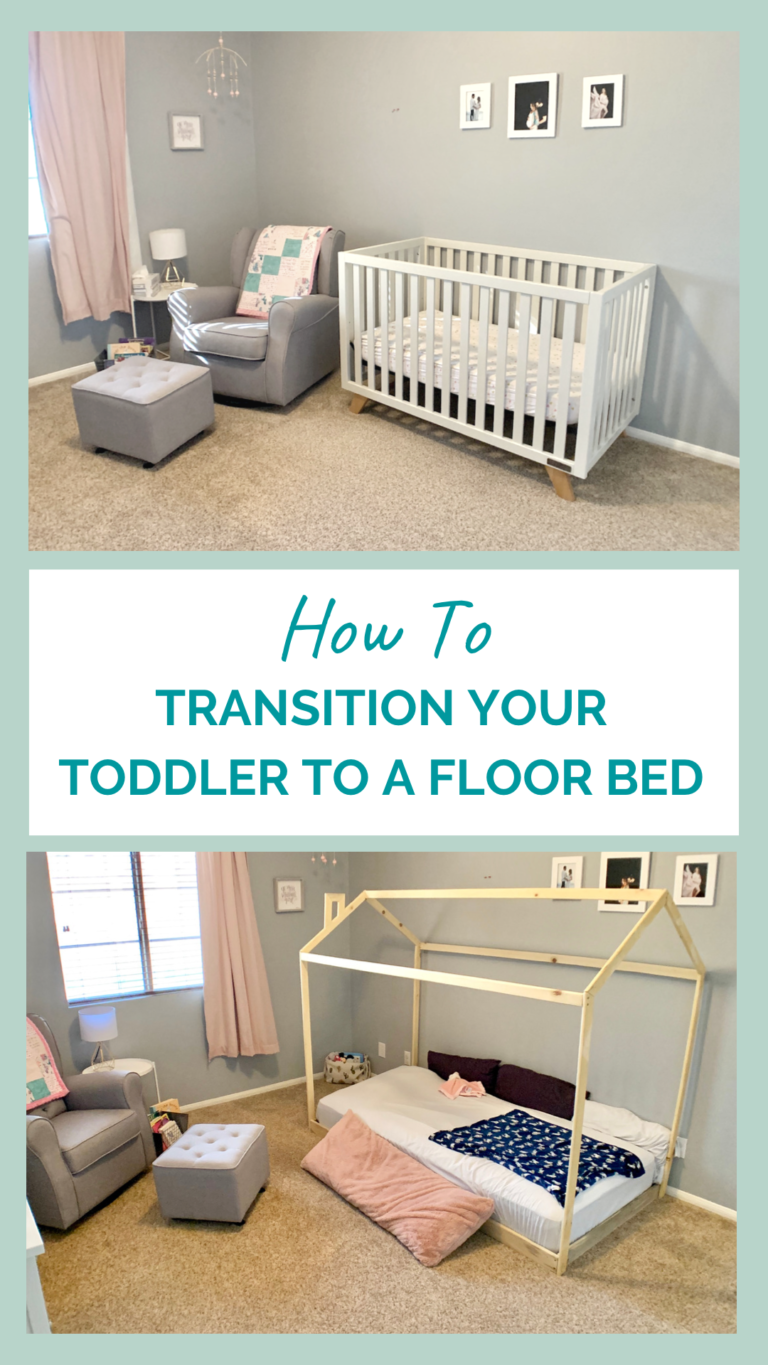
What is a Montessori floor bed?
Maria Montessori was an Italian physician, educator, and innovator in the early 1900’s. She made ground-breaking innovations in education that are still popular today. Throughout my Montessori training, I never heard of the floor bed. I only recently came across this idea when having Ruby (now 15 months).
So, why does a toddler floor bed get equated with the Montessori approach?
Although the floor bed is not a prominent teaching during Montessori teacher training, it is a concept that Maria Montessori valued. She believed that infants should not be caged in cribs, but instead allowed the freedom of movement right from the start and even for sleep.
The Montessori approach values independence, making choices, and freedom of movement for even the youngest learners. These values are definitely inherent with the toddler floor bed.
Does it need to look like a house?
The house frame has only recently become a popular decor choice and it is not synonymous with a Montessori floor bed.
Is it beautiful? Yes!
Is it necessary? No.
I have seen many ways to approach the floor bed concept. You could use your crib and take off one side and the legs so it sits on the floor. You could simply put a mattress on the floor. Or you could buy a simple floor bed frame.
Benefits
I get many questions about why I chose the floor bed and what are the benefits. These are super important questions to consider because, I will be honest with you, transitions are hard. You may want to give up. I wanted to give up on about day 3. It was important for me to remember my “why” and the benefits of transitioning so that I would keep with it.
In a way, the benefits of transitioning to a floor bed are a personal decision and vary from family to family. There are some benefits for all families, but each family needs to weigh these benefits with their current situation and beliefs. Ultimately, the decision is yours and nobody needs to pressure you to make the decision one way or the other…not even me.
Like I mentioned above, the floor bed has become synonymous with the Montessori approach for the ability to provide independence, choices, and freedom of movement. These are the top benefits that would apply to most.
These values contribute to the learning process even beyond the classroom. They say “learning starts at home” and this is an example of how parents build the foundation for future learning and life skills.
The ability to freely move to and from their bed empowers the toddler with decision making and independence. They are no longer waiting for you to come into the room to get them out of their bed. They choose from the moment they wake up what they do and where they go.
This often scares parents because they fear their toddler will choose to play with the toys in their room or choose to leave the bed and stay up all night.
Transitioning to a toddler floor bed takes a certain amount of trust and respect for your young child. I believe that even babies and toddlers are capable human beings (which aligns with the Reggio and Montessori approaches to learning). When we foster this trust and independence, the toddler also develops their capacity for trust and independence. If we choose to make decisions based on fear, then their choices will reflect fear as well.
Does this mean I am Super Mom and I have none of these fears and worries? Heck no! Of course I have these common worries and concerns for my tiny child, but I try not to let those anxieties determine the choices I make for her and our family.
Some of our personal reasons WHY we chose a floor bed are:
- We are expecting a baby boy in December, so I wanted the transition before Ruby had to manage another life change. Plus, I wanted to save money on buying another crib.
- It was getting hard for me to lift and place her over the crib rail with a big pregnant belly.
- Transitioning when they are younger is easier because sometimes they haven’t gotten to the “toddler power struggles with sleep” phase and they can’t open the door on their own yet.
- Ruby is a good sleeper and enjoys her bed.
- Ruby does move around quite a bit, so if she rolled off the bed she wouldn’t fall far and, therefore, she would avoid injury.
- My husband and I agreed it was a good time and we were committed to working together through the transition
Timing
Another question I get asked a lot is how old Ruby was when we transitioned to the floor bed and what is the best time to transition. This is another one that is dependent on your family’s beliefs and situation. There is not one “perfect” time to transition. You really have to think about your own child, family, and the benefits for you.
I have seen children as young as a few months old (and heard about babies as young as 2 weeks) on a floor bed and I have heard of children up to around 4 still in a crib. So, the perfect time really varies.
Ruby had just turned 15 months old when we started to transition to a floor bed. This timing worked out well for us. She was down to one nap a day and she was sleeping through the night without any problems (except for the random night here and there, which wasn’t even a huge problem).
We also had a bunch of house guests right before, so we waited until they were gone. We had to move the guest room furniture out in preparation for the baby boy’s nursery and this allowed us a place to move the crib.
We probably could have transitioned a little earlier, but we had to consider our family and household situation. I am glad we waited for her to drop down to one nap because her naps did get a little messed up (she fights them a little more and sometimes will skip the nap). Moving to one nap is a transition on its own and the goal of the “perfect” time for us was to limit the amount of transitions she had to go through at one time.
The process
The process to transition to a floor bed which we followed worked out well for us. Again, different families will approach the process in various ways and that is ok too. Here is the step by step guide how we transitioned.
Before
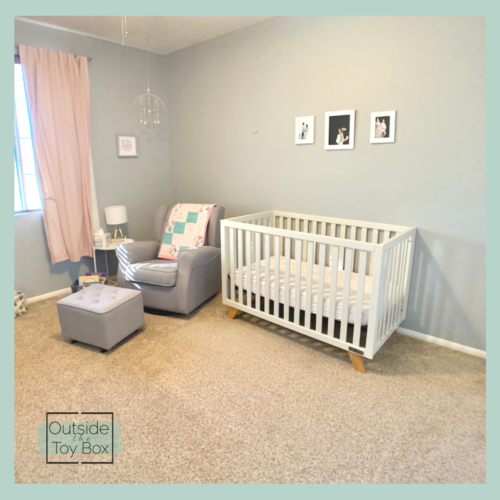

Step 1 Baby-Proof the Room
We had to consider where cords were, all outlet plugs were covered, any dangerous items taken out. Honestly, her room was pretty much already baby-proofed. She only opened the door once, but we did add a gate to the top of the stairs for extra precaution.
You will need to determine the personality of your child to determine how much you need to baby proof the room.
Consider things like:
How much they fight sleep
How much they move in their sleep
Their physical capabilities (ie. are they able to crawl out of their bed, are they crawling, walking, climbing, etc.)
How mischievous they are
How curious they are of their surroundings
How much or how little they play in their room currently
Something else to consider is that there aren’t too many distractions. So, hopefully you do not use your toddler’s room as a playroom because that might be too distracting. Ruby’s room already had minimal toys or distractions in the room. We left out some books and stuffed animals, but other than that there were no toys to play with.
Also, consider having a good video monitor to keep a close eye on what they do and if they do get up and out of bed. Oftentimes Ruby wakes up and gets out of bed very quietly and waits for us by her door. If I didn’t have a video monitor I might miss that she is even awake.
Step 2 Start with Nap time and let them play on the bed while awake
The next thing we did was put the crib mattress on the floor next to the crib and put a body pillow on the other side of the mattress for nap time. The first nap went really well so we continued napping on the mattress on the floor. We would simply pull the mattress out for nap time and then replace it in the crib for overnight sleeping. We continued with this for a week.
When it was awake time (not getting ready for nap time) I would allow her to play on the mattress. She would climb in and out, cuddle her blanket, bring books onto the bed, read books with her in bed, and even jump on the bed.
I did this so she would become comfortable with the new bed, she would begin to understand the space, understand the sides drop off instead of having a wall around it, and so that she would have practice climbing in and out.
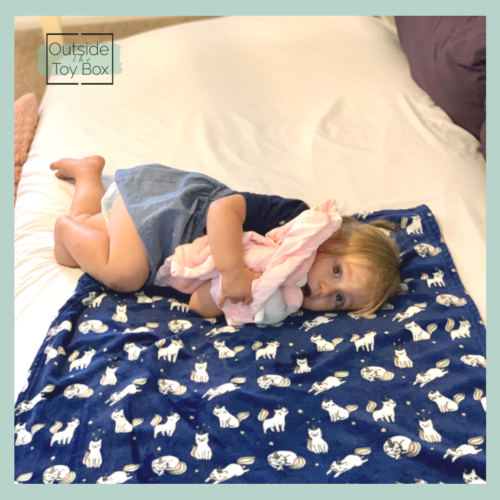
Step 3 Twin Mattress on the floor
After she was sleeping well on the crib mattress for naps, we put the twin size mattress on the floor next to the crib.
You could easily remove the crib and go to your floor bed mattress at this point, but I wasn’t fully committed to the twin mattress and no crib yet. I wanted to make sure that she was ok on the bigger and taller bed for both nap and overnight before I removed the crib completely.
Again, we played on the mattress to get comfortable with it while she was awake.
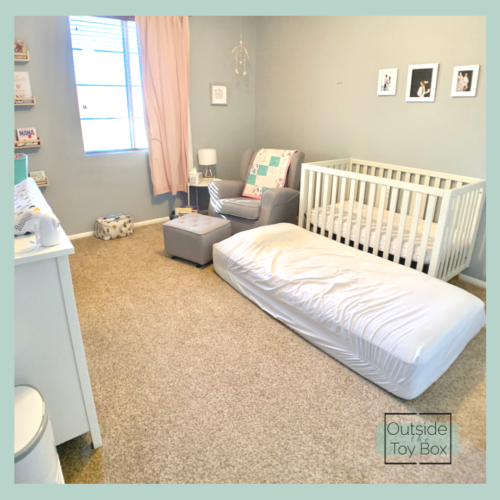
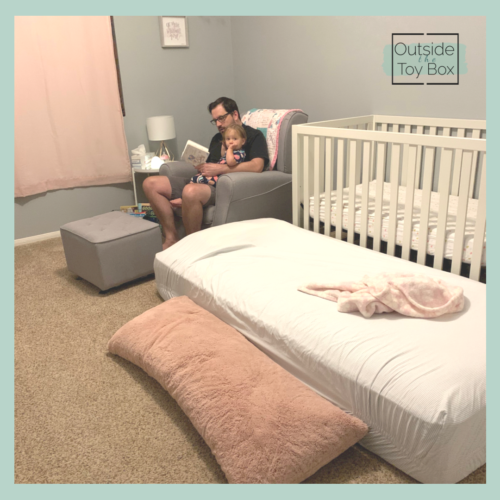
Step 4 Remove the crib
When I was confident with my decision and her ability to sleep both naps and overnight on the twin mattress, we completely removed the crib and put together her house bed frame. I also got her mattress sheets with something she loves on them…cats.
It was so fun to show her the new “big girl” bed frame. She was surprised and excited. She really loves her cat sheets too (cat sheets not pictured).
She saw her crib in the other room and she did want to get in it when she saw it. I let her and didn’t shame her by saying anything like, “That’s your brother’s bed now, that’s for babies not for you, that isn’t your bed anymore, you are a big girl you don’t need a crib anymore.” All of these statements could affect her confidence in her new sleeping arrangement.
Instead, I let her have all the time she needed in her old bed. I said things like, “That’s your crib in a new room. Do you miss your crib? You love your bed.”
After
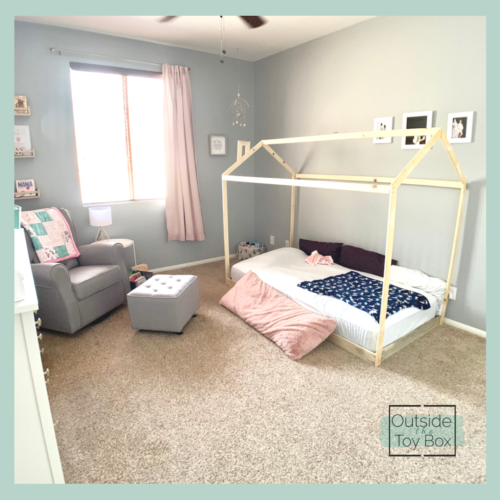
Do you love this bed frame? Check out similar ones HERE.
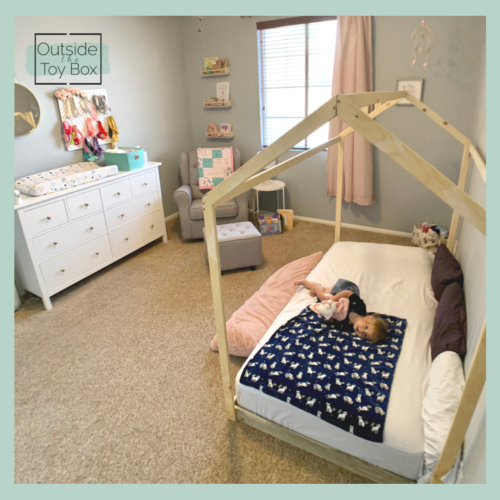
She loves her new bed and she loves her kitty blankets.
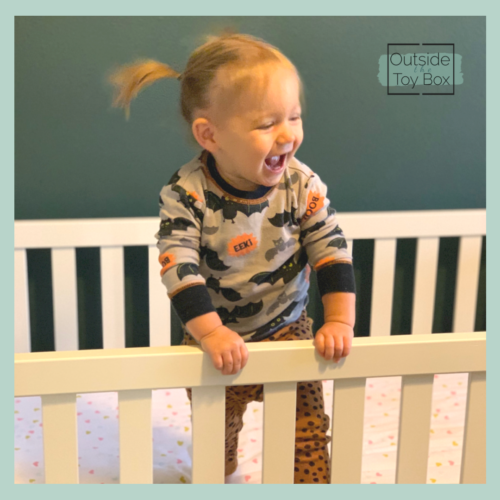
Playing in her crib in her baby brother’s room.
Floor Bed Frame and Mattress
People also ask about where I got our House bed frame and mattress. We were lucky enough that my dad gave us his old twin mattress that was in excellent condition. He is also super handy and made the bed frame for us and helped us put it together.
If you are looking for something similar there are some really amazing options on Etsy. I have seen bed frames for all different mattress sizes. You could also DIY your own or simply put your crib mattress on the floor.
Here are some great looking options for floor bed frames:
Sweet Home From Wood House Floor Bed Frame
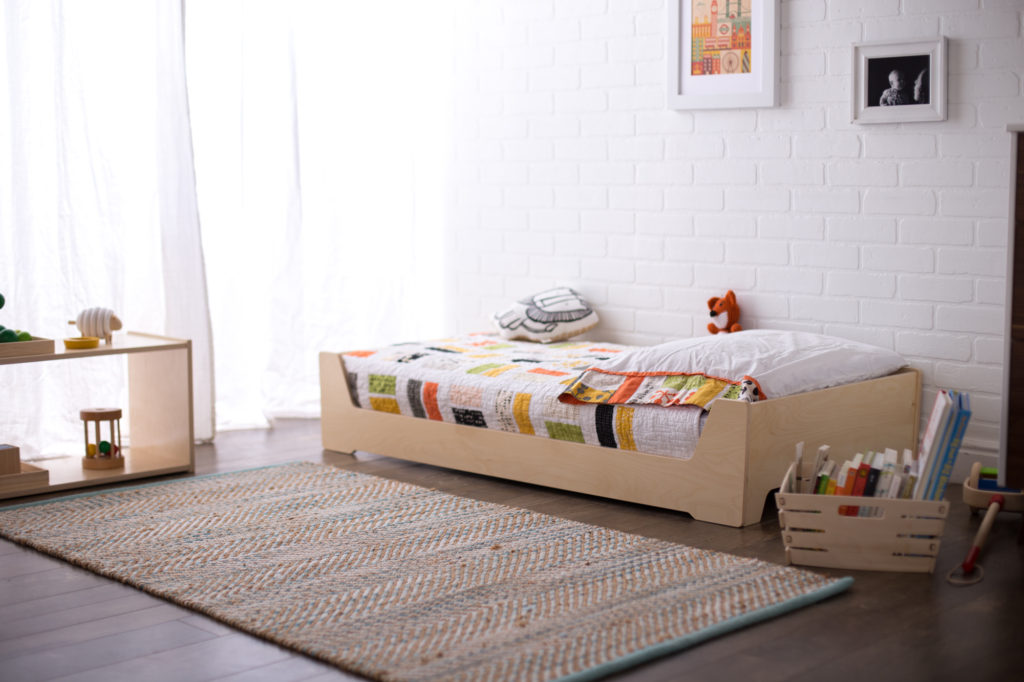
Sprout Kids Montessori Floor Bed
Problems
Was the process smooth with no problems? No.
Did I want to give up at times? Yes.
Was it absolutely disastrous and traumatizing? Not at all.
Like I said before, transitions are hard, but children are resilient. Ruby continuously surprises me with her flexibility. It is truly inspiring.
There were a few times when we were at step 2 napping on the crib mattress on the floor that she fought taking a nap or had a shorter nap. I think she was also consolidating her transition to one nap a day.
On day 2 or 3 of step 3 twin mattress on the floor for all sleep, I really started doubting myself and wanted to give up. Before this transition process Ruby was sleeping about 8 PM to 8 AM give or take an hour on both sides. She was also napping for a good 1.5 to 2 hours each day.
When we transitioned to the twin mattress, she woke up at 6:30 AM and really started to resist napping, nap later, nap shorter, or skip more naps completely.
She also rolled out of the bed twice (1 AM and 3 AM) the first night. Luckily this didn’t wake her up, but it woke us up and we had to go in there to place her back in the bed, which meant less sleep for us.
So, yes, I really needed to remember why I did this in the first place. I also needed support from my husband and others who had gone through a similar transition (I love my Instagram followers). I’m so glad that I did have that support and had strong reasoning for why we started this journey in the first place because we powered through the struggles and, one month later, she is doing really well and her sleep is getting back to normal.
Now we don’t need to buy a new crib for baby boy and Ruby doesn’t have to transition when she also has other life changes. Ruby is growing a new sense of independence and self-regulation. I feel at peace with our decision. In my opinion the challenges of the transition are worth the rewards.
You might also find these items interesting:
Baby Nest Shop Floor Bed Bumpers
NeymDesign Personalized Toddler Bedding
Remember, this is only one story and one “How-to” guide. Your “How-to” might look different than mine. Every child and every family is different. I would love to hear your story in the comments.
Please don’t hesitate to reach out to me if you have questions. This is our story, but I would love to help you along your journey.

Share on facebook
Facebook
Share on pinterest
Pinterest
Share on email
Email
Share on print
Print
Please help to support my blogging efforts by sharing this post to others who may find some value in its contents.
Subscribe to Stay up to date
We will send you updates, but promise never to spam you (who has time for that?)
Follow us on Social Media to get daily play inspiration.



